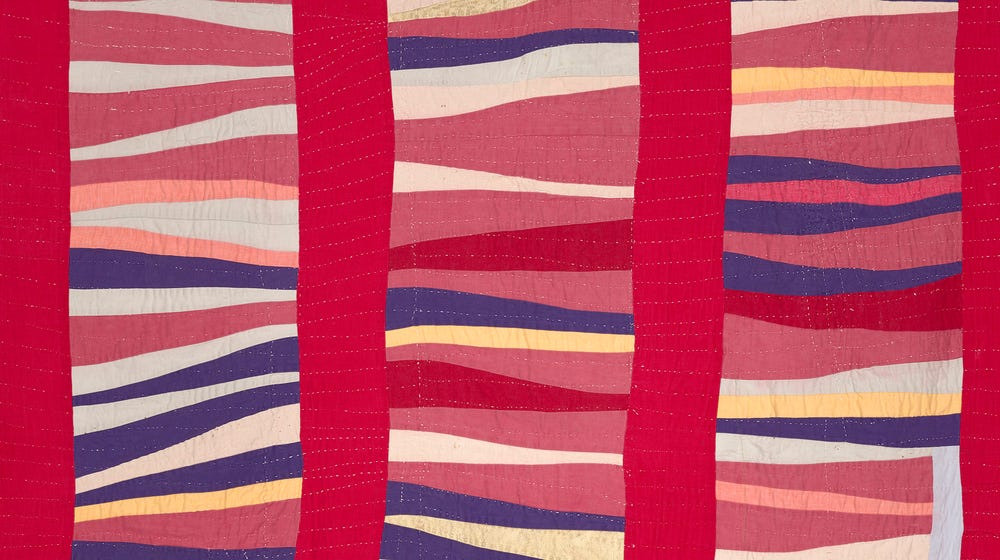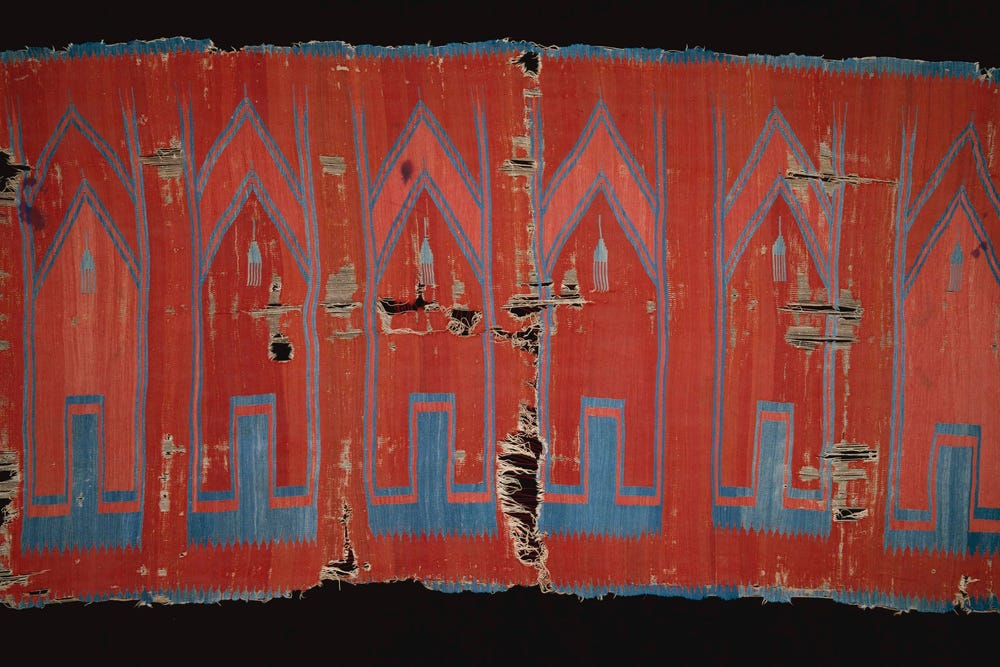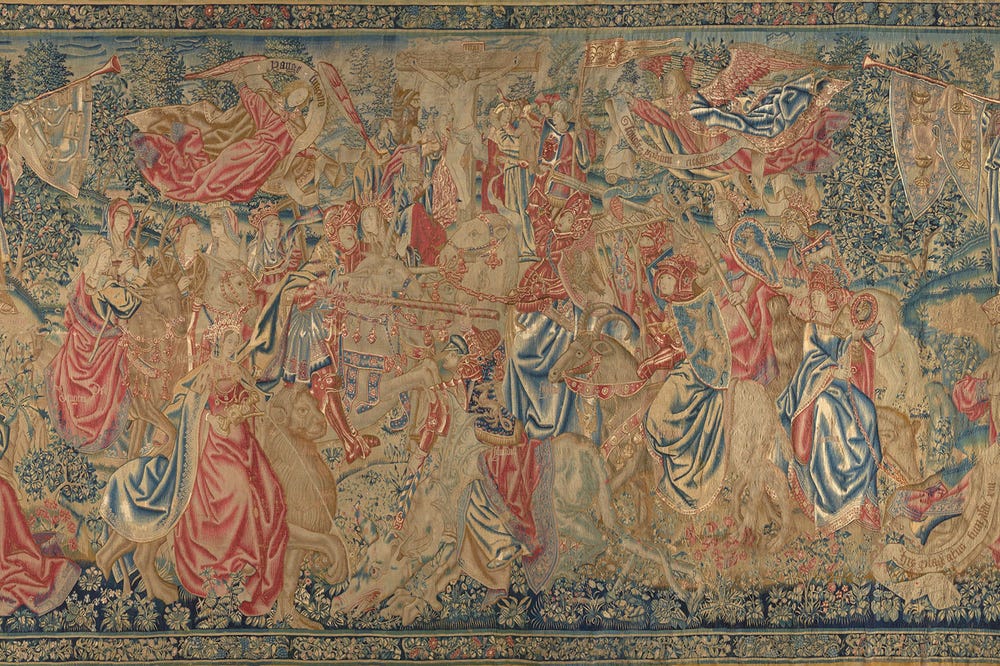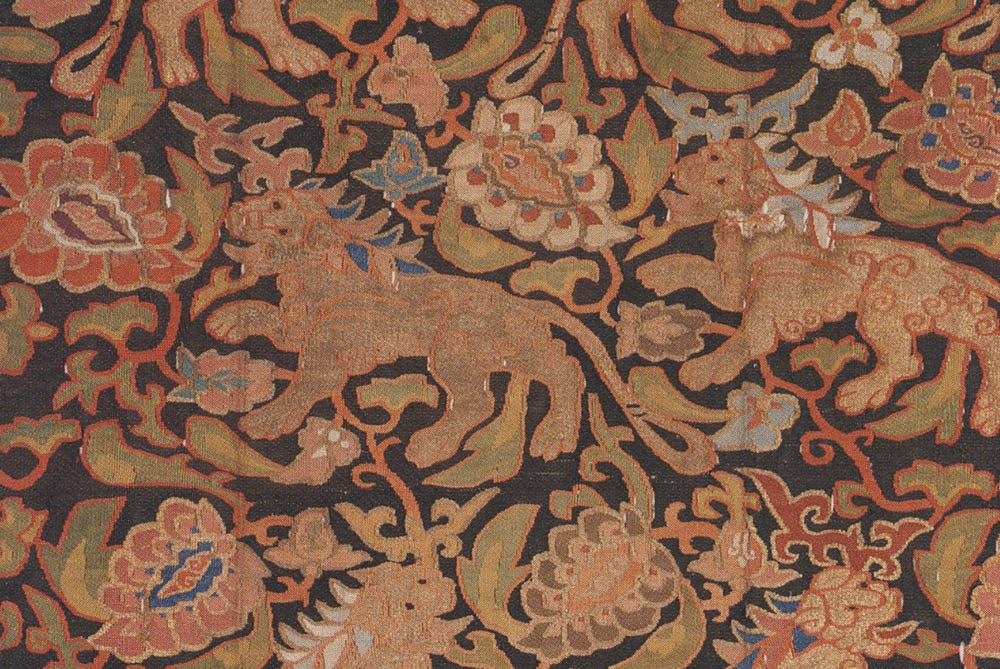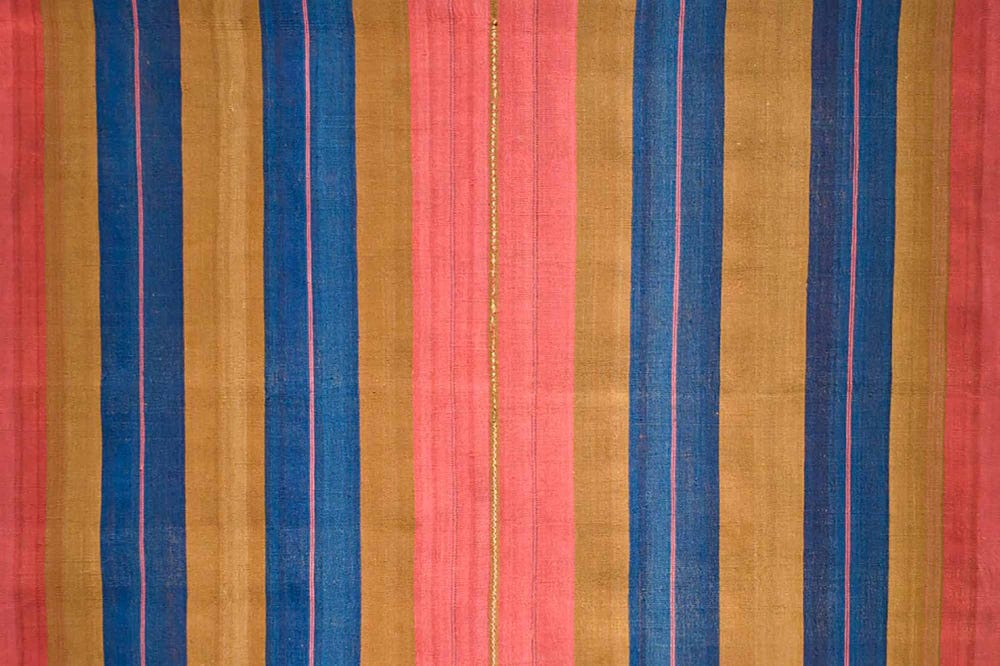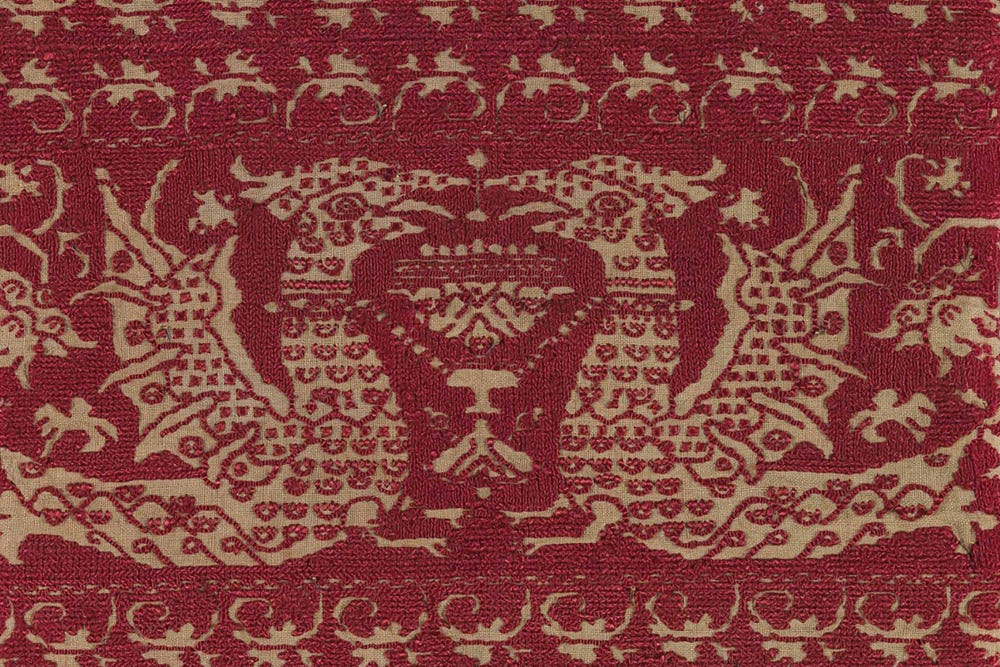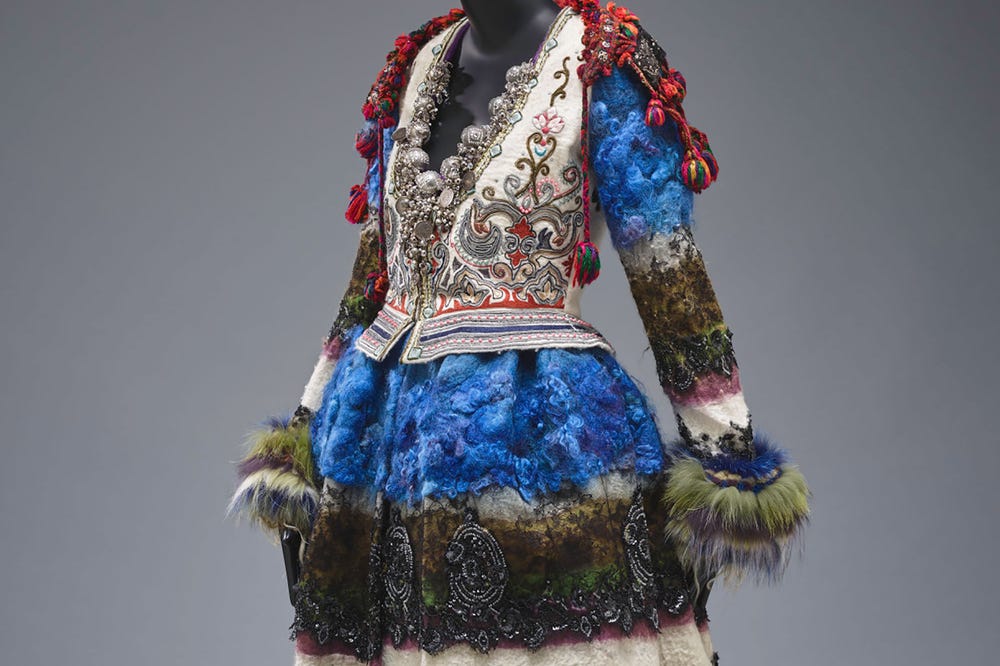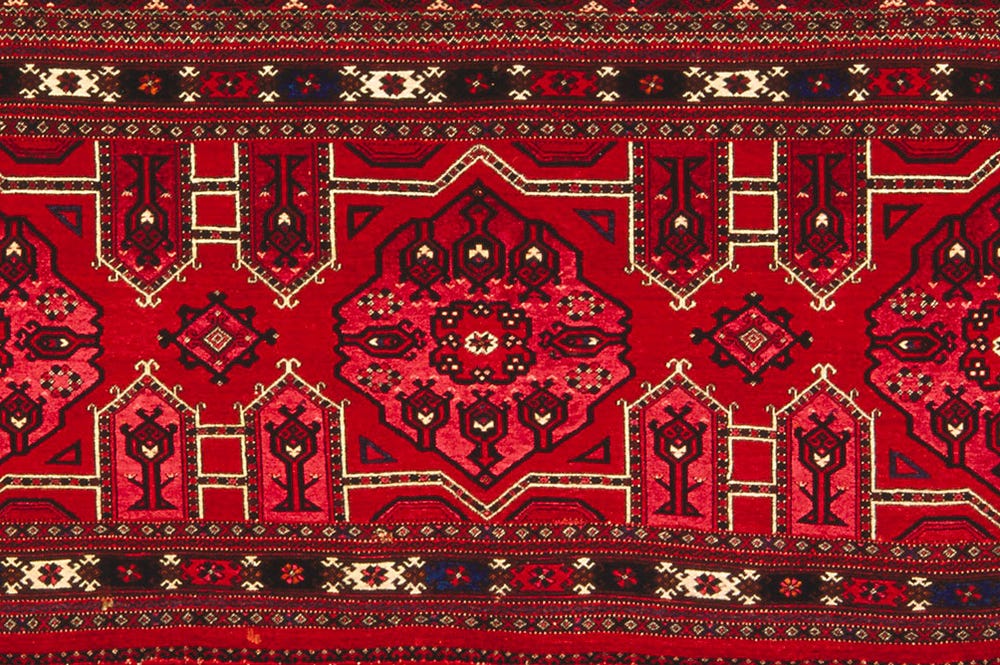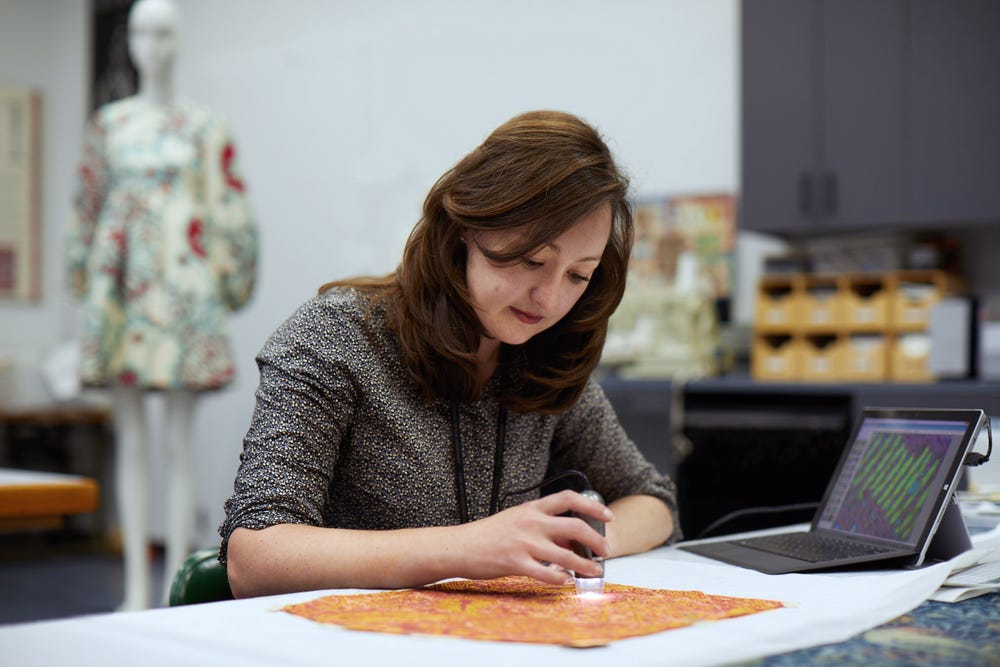Jessie T. Pettway, Bars and string-pieced columns (detail), 1950–1960. Cotton plain weave; pieced and quilted, 95 x 76 in. (241.3 x 193 cm). Museum purchase, American Art Trust Fund, and gift of the Souls Grown Deep Foundation from the William S. Arnett Collection, 2017.1.42. ©️ Jessie T. Pettway / Artist Rights Society (ARS), New York. Photograph by Randy Dodson
About Costume + textile arts
With holdings that span nearly three millennia and represent cultures from 125 countries, the costume and textile arts collection draws connections across cultures and enriches other areas of the permanent collection. The Caroline and H. McCoy Jones Department of Textile Arts contains more than 14,000 textiles and costumes from around the world. A remarkable range of techniques is represented in the works, which include loom-woven textiles, nonwoven fabrics (such as bark cloth, felt, and knitting), and objects embellished with beading and embroidery.
Highlights from the collection include extraordinary Turkmen carpets, rare 12th- through 15th-century Central Asian and North Indian silks, the most important group of Anatolian kilims outside Turkey, European tapestries, exquisite ecclesiastical textiles, and contemporary Bay Area fiber art. The de Young is known for its 20th-century couture, particularly from the post–World War II era, with outstanding pieces by Cristóbal Balenciaga, Coco Chanel, Christian Dior, Madame Grés, and Yves Saint Laurent.
-
The Caroline and H. McCoy Jones Collection
H. McCoy Jones (1897 – 1987) was a scholar, a collector of nomadic tribal rugs, and the founder of the International Hajji Baba Society, a nonprofit dedicated to the understanding and appreciation of fine textiles. In 1980, he and his wife, Caroline (1917 – 2006), made the commitment to donate his collection of more than 600 Central Asian carpets and textiles to the Fine Arts Museums of San Francisco, transforming the Museums into one of the greatest repositories of Central Asian textiles in the United States. After his death in 1987, Caroline expanded her husband’s collection, focusing on Central Asian and South American textiles, and gifted significant collections of Anatolian kilims and global headwear. Their estate was gifted to the Textile Arts department in 2006. For their enduring contributions, the department is named in their honor. In recent years, the Caroline and H. McCoy Jones Collection has been enriched by donations from the Wolfgang and Gisela Wiedersperg Collection and the George and Marie Hecksher Collection.
Kilim (detail), 17th–18th century. Turkey, Central Anatolia, Ankara Province. Wool, dovetail, and slit-tapestry weave, 65 3/4 x 142 15/16 in. (16.7 x 36.3 cm.). Fine Arts Museums of San Francisco, The Caroline and H. McCoy Jones Collection, Gift of Caroline McCoy-Jones, 2003.87.5
-
The European Tapestry Collection
Our tapestry collection is one of the most important and diverse in the United States. Both the de Young and Legion of Honor have collected tapestries since their founding. While the de Young’s tapestries were selected and purchased, the Legion’s tapestry holdings were largely formed by gifts from private individuals. After the de Young and Legion merged to form the Fine Arts Museums of San Francisco in 1972, tapestries continued to be acquired through purchase, gift, and bequest. Under the volunteer stewardship of husband-and-wife Ralph Bennett (1900–1994) and Anna Gray Bennett (1917–2012) in the 1970s, the Museums’ tapestries were cleaned, conserved, and researched. For her devotion to the collection, Bennett was named founding curator of the Textile Arts department in 1983. Today, highlights of the European collection include rare Gothic tapestries, works by the esteemed French manufactories of Aubusson, Gobelins, and Beauvais, and the largest concentration of panels from the famous The Redemption of Man series outside of Europe.
The Combat of the Virtues and the Vices, from The Redemption of Man series (detail), 1510–1515, Belgium, Brussels. Wool, silk, tapestry weave, 164 x 314 in. (416.6 x 797.6 cm). Gift of The William Randolph Hearst Foundation, 54.14.4
-
The George and Marie Hecksher Collection
In 1999, Fine Arts Museums Board Member George Hecksher and his wife, Marie, gave their major collection of early Middle Eastern and Central Asian rugs and rare Central Asian and North Indian silks to our Textile Arts department. By this remarkable gift, the Hecksher’s solidified the Museums’ position as one of the foremost collectors of Central Asian carpets and early silks in the world. The Hecksher’s gift was furthered by a generous donation of funds to support the development of the Textile Arts department’s facilities, including galleries, conservation laboratories, and storage. By their ongoing philanthropy, the Heckshers have enabled the Museums to enrich and care for its encyclopedic costume and textiles collection for more than 20 years.
Fragment (detail), 11th–13th century, Central Asia. Silk, metallic thread, slit tapestry with eccentric wefts (kesi), 25 3/16 x 14 3/16 in. (64 x 36 cm). Gift of George and Marie Hecksher, 2002.184.2
-
The Jeffrey Appleby Collection
The Jeffrey Appleby Collection represents the majority of our South American holdings, augmented by a modest number of exceptional pre-Hispanic and Spanish Colonial textiles. Collector and dealer Jeffrey Appleby gifted his large collection of Andean textiles to the Museums in 1992. Made for both everyday and ceremonial use, the textiles date primarily from the 19th and 20th centuries, with some Colonial-era examples, and come from the present-day countries of Argentina, Bolivia, Chile, Ecuador, and Peru.
Woman's mantle (iscayo) (detail), early 19th century. Bolivia, Pacajes province, La Paz, Aymara. Sheepswool or camelid, warp-faced plain weave, 45 1/2 x 36 9/16 in. (115.5 x 92.8 cm). The Jeffrey Appleby Andean Textile Collection, 1992.107.152
-
The Julia Brenner Textile Collection
Among our foundational holdings is the collection of Julia Brenner (1866–1944), a native San Franciscan and member of a prominent mercantile family. In the 1920s and 1930s, she donated more than 1,000 textiles, fragments, costume components, costume accessories, and tools to the Museums. Her collection, dating from antiquity to the 20th century, includes examples of fine textile weaves and techniques from various corners of the globe. Since its receipt, the collection has served as an educational resource and source of inspiration to generations of visitors, including weavers, designers, and art students.
Textile fragment (detail), 15th–19th century, Italy. Linen and silk, embroidery (basket, double-running, and cross stitch), 19 5/16 x 10 5/8 in. (49 x 27 cm). Gift of Julia Brenner Collection, 53808.15
-
The Western Costume Collection
The Museums have collected and displayed Western women’s costume since their inception. During the 1950s, the collection benefitted from the patronage of Grover Magnin (1885–1969), president of I. Magnin department store and member of the Museums’ Board of Trustees, and his wife, Jeanne (1896–1986), who donated many iconic gowns by French couturier Christian Dior. In 1985, the Museums’ 20th-century costume collection was transformed by the generous gift of post-World War II haute couture and high fashion from international style arbiter Eleanor Christenson de Guigné (1911–1983). Her gift includes pivotal designs by seminal couturiers such as Christian Dior, Cristóbal Balenciaga, and Yves Saint Laurent. The collection has expanded greatly, spurred by the success of the Museums’ fashion program. Contemporary strengths include the work of Comme des Garçons, John Galliano, Jean Paul Gaultier, Karl Lagerfeld for Chanel, Alexander McQueen, and Vivienne Westwood.
Christian Lacroix (designer), French, b. 1950. Woman's ensemble: coat (a) and dress (b), Haute Couture Autumn/Winter 2007, France, Paris. (a) wool, goat hair, animal fur, silk, metallic thread; felt, crochet, lace appliqué, charmeuse, couched threads; (b) wool, metal, crystal; bouclé, coins, balls and beads (detail), 109.2 cm (43 in.) center back length (a); 104.1 cm (41 in.) center back length (b). Gift of Christine Suppes in honor of Jill D'Alessandro, 2017.75.1a-b
-
The Wolfgang and Gisela Wiedersperg Collection
In 1997, the Fine Arts Museums received a major collection of Turkmen weavings from San Francisco residents Wolfgang (1915–1999) and Gisela Wiedersperg (1919–2006). The couple had a lifelong interest in travel, which enabled them to build a significant collection of more than 80 objects, with representations of work by all major weaving tribes.
Camel trapping for a bridal procession (kejebelik) (detail), ca. 1800–1850. Central Asia, Turkmen, Salor tribe. Wool, silk, knotted pile (asymmetrical knot, open to the left), 36 x 85 in. (91.4 x 215.9 cm). Wiedersperg Collection, Gift of Wolfgang and Gisela Wiedersperg, 1997.142.7
-
Joan Diehl McCauley Textile Study Center
Contact information
Laura L. Camerlengo
Curator in Charge of Costume and Textile Arts
lcamerlengo@famsf.orgHours
By appointment only.
The Joan Diehl McCauley Textile Study Center is located at the de Young on the second floor, adjacent to the Textile Gallery, and is available to researchers with a specific focus of study by appointment only.
The Textile Study Center supports our educational mission through scholarship in textiles and costumes from traditions around the world. The materials comprising the Textile Study Center's research collection reflect the breadth and diversity of the costume and textile arts collection, which contains over 14,000 objects.
